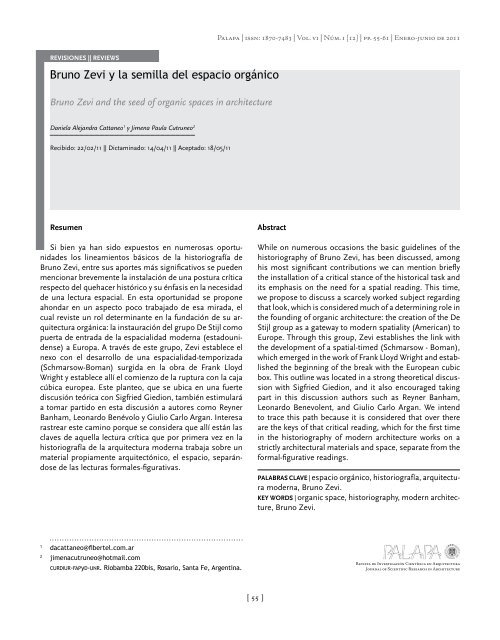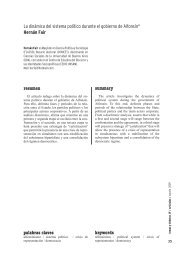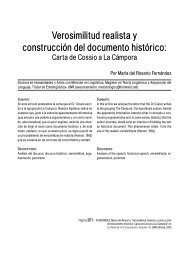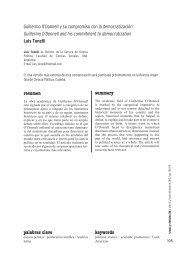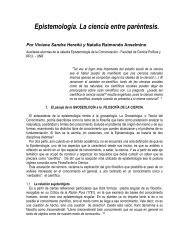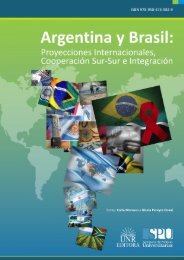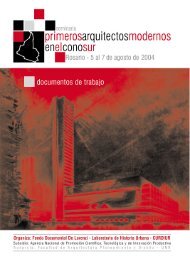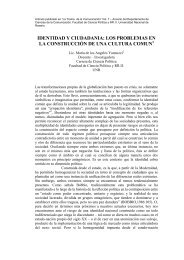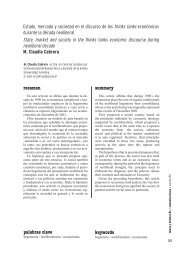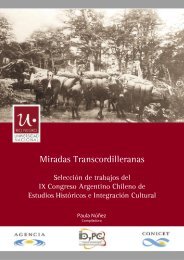Palapa Cattaneo.pdf - Universidad Nacional de Rosario
Palapa Cattaneo.pdf - Universidad Nacional de Rosario
Palapa Cattaneo.pdf - Universidad Nacional de Rosario
You also want an ePaper? Increase the reach of your titles
YUMPU automatically turns print PDFs into web optimized ePapers that Google loves.
<strong>Palapa</strong> | issn: 1870-7483 | Vol. vi | Núm. i [12] | pp. 55-61 | Enero-junio <strong>de</strong> 2011<br />
REVISIONES || REVIEWS<br />
Bruno Zevi y la semilla <strong>de</strong>l espacio orgánico<br />
Bruno Zevi and the seed of organic spaces in architecture<br />
Daniela Alejandra <strong>Cattaneo</strong> 1 y Jimena Paula Cutruneo 2<br />
Recibido: 22/02/11 || Dictaminado: 14/04/11 || Aceptado: 18/05/11<br />
Resumen 12<br />
Si bien ya han sido expuestos en numerosas oportunida<strong>de</strong>s<br />
los lineamientos básicos <strong>de</strong> la historiografía <strong>de</strong><br />
Bruno Zevi, entre sus aportes más significativos se pue<strong>de</strong>n<br />
mencionar brevemente la instalación <strong>de</strong> una postura crítica<br />
respecto <strong>de</strong>l quehacer histórico y su énfasis en la necesidad<br />
<strong>de</strong> una lectura espacial. En esta oportunidad se propone<br />
ahondar en un aspecto poco trabajado <strong>de</strong> esa mirada, el<br />
cual reviste un rol <strong>de</strong>terminante en la fundación <strong>de</strong> su arquitectura<br />
orgánica: la instauración <strong>de</strong>l grupo De Stijl como<br />
puerta <strong>de</strong> entrada <strong>de</strong> la espacialidad mo<strong>de</strong>rna (estadouni<strong>de</strong>nse)<br />
a Europa. A través <strong>de</strong> este grupo, Zevi establece el<br />
nexo con el <strong>de</strong>sarrollo <strong>de</strong> una espacialidad-temporizada<br />
(Schmarsow-Boman) surgida en la obra <strong>de</strong> Frank Lloyd<br />
Wright y establece allí el comienzo <strong>de</strong> la ruptura con la caja<br />
cúbica europea. Este planteo, que se ubica en una fuerte<br />
discusión teórica con Sigfried Giedion, también estimulará<br />
a tomar partido en esta discusión a autores como Reyner<br />
Banham, Leonardo Benévolo y Giulio Carlo Argan. Interesa<br />
rastrear este camino porque se consi<strong>de</strong>ra que allí están las<br />
claves <strong>de</strong> aquella lectura crítica que por primera vez en la<br />
historiografía <strong>de</strong> la arquitectura mo<strong>de</strong>rna trabaja sobre un<br />
material propiamente arquitectónico, el espacio, separándose<br />
<strong>de</strong> las lecturas formales-figurativas.<br />
Abstract<br />
While on numerous occasions the basic gui<strong>de</strong>lines of the<br />
historiography of Bruno Zevi, has been discussed, among<br />
his most significant contributions we can mention briefly<br />
the installation of a critical stance of the historical task and<br />
its emphasis on the need for a spatial reading. This time,<br />
we propose to discuss a scarcely worked subject regarding<br />
that look, which is consi<strong>de</strong>red much of a <strong>de</strong>termining role in<br />
the founding of organic architecture: the creation of the De<br />
Stijl group as a gateway to mo<strong>de</strong>rn spatiality (American) to<br />
Europe. Through this group, Zevi establishes the link with<br />
the <strong>de</strong>velopment of a spatial-timed (Schmarsow - Boman),<br />
which emerged in the work of Frank Lloyd Wright and established<br />
the beginning of the break with the European cubic<br />
box. This outline was located in a strong theoretical discussion<br />
with Sigfried Giedion, and it also encouraged taking<br />
part in this discussion authors such as Reyner Banham,<br />
Leonardo Benevolent, and Giulio Carlo Argan. We intend<br />
to trace this path because it is consi<strong>de</strong>red that over there<br />
are the keys of that critical reading, which for the first time<br />
in the historiography of mo<strong>de</strong>rn architecture works on a<br />
strictly architectural materials and space, separate from the<br />
formal-figurative readings.<br />
PALABRAS CLAVE | espacio orgánico, historiografía, arquitectura<br />
mo<strong>de</strong>rna, Bruno Zevi.<br />
KEY WORDS | organic space, historiography, mo<strong>de</strong>rn architecture,<br />
Bruno Zevi.<br />
1<br />
dacattaneo@fibertel.com.ar<br />
2<br />
jimenacutruneo@hotmail.com<br />
curdiur-fapyd-unr. Riobamba 220bis, <strong>Rosario</strong>, Santa Fe, Argentina.<br />
Revista <strong>de</strong> Investigación Científica en Arquitectura<br />
Journal of Scientific Research in Architecture<br />
55


